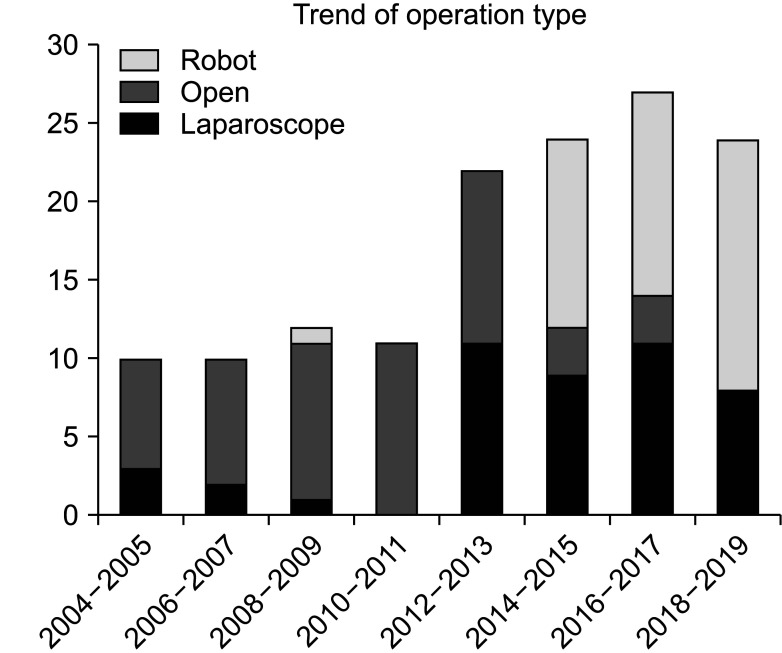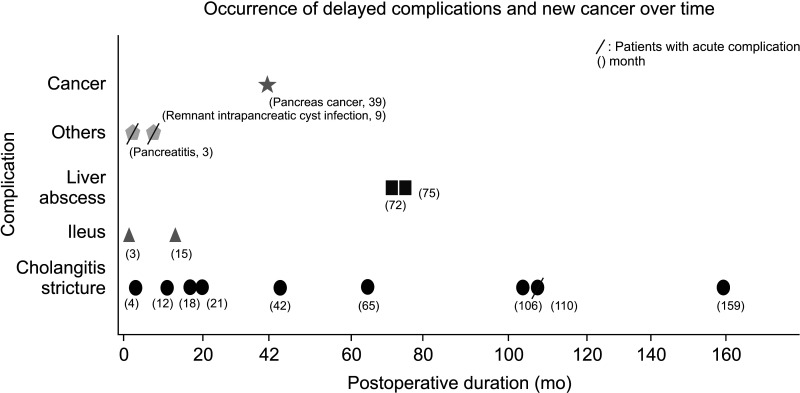Ann Surg Treat Res.
2021 Dec;101(6):332-339. 10.4174/astr.2021.101.6.332.
Clinical characteristics of patients with malignancy and long-term outcomes of surgical treatment of patients with choledochal cyst
- Affiliations
-
- 1Division of Hepatobiliary and Pancreatic Surgery, Department of Surgery, Seoul National University College of Medicine, Seoul, Korea
- KMID: 2522930
- DOI: http://doi.org/10.4174/astr.2021.101.6.332
Abstract
- Purpose
There are few reports of postoperative long-term malignant risk or postoperative sequelae after surgery for choledochal cysts (CCs). This study aimed to analyze the clinical characteristics of patients with malignancy and the longterm results of operated CC.
Methods
The patients who underwent surgical treatments for CC between 2003 and 2020 at Seoul National University Hospital were enrolled. Clinicopathologic factors and pre-/postoperative computed tomography or magnetic resonance imaging were reviewed.
Results
Of the 153 patients, Todani classification Ic (36.6%), C-P type (43.8%) anomalous pancreaticobiliary duct union were the most common type respectively. Fourteen patients (9.2%) had biliary tract cancer and a comparison of patients with and without malignancy showed that the diameter of cyst was significantly lower in malignant patients and malignancy was observed to be significantly higher in P-C type. The incidence of long-term complications was 9.8%, and the median time interval was 30 months. The 2 most common complications were cholangitis and stricture (60.0%). There was one case of new cancer near the intrapancreatic remnant bile duct.
Conclusion
Of the resected CCs, 9.2% had a combined malignancy on the biliary tracts. Long-term complications such as cholangitis, anastomotic stricture, and new cancers may occur. Therefore, continuous surveillance is required.
Keyword
Figure
Reference
-
1. Shah OJ, Shera AH, Zargar SA, Shah P, Robbani I, Dhar S, et al. Choledochal cysts in children and adults with contrasting profiles: 11-year experience at a tertiary care center in Kashmir. World J Surg. 2009; 33:2403–2411. PMID: 19701664.
Article2. Yamaguchi M. Congenital choledochal cyst: analysis of 1,433 patients in the Japanese literature. Am J Surg. 1980; 140:653–657. PMID: 6776832.3. Kamisawa T, Ando H, Suyama M, Shimada M, Morine Y, Shimada H, et al. Japanese clinical practice guidelines for pancreaticobiliary maljunction. J Gastroenterol. 2012; 47:731–759. PMID: 22722902.
Article4. Edil BH, Cameron JL, Reddy S, Lum Y, Lipsett PA, Nathan H, et al. Choledochal cyst disease in children and adults: a 30-year single-institution experience. J Am Coll Surg. 2008; 206:1000–1008. PMID: 18471743.
Article5. Nagata E, Sakai K, Kinoshita H, Hirohashi K. Choledochal cyst: complications of anomalous connection between the choledochus and pancreatic duct and carcinoma of the biliary tract. World J Surg. 1986; 10:102–110. PMID: 3962321.
Article6. Jang SM, Lee BS, Kim KK, Lee JN, Koo YS, Kim YS, et al. Clinical comparison of choledochal cysts between children and adults. Korean J Hepatobiliary Pancreat Surg. 2011; 15:157–163. PMID: 26421033.
Article7. Lee SE, Jang JY, Lee YJ, Choi DW, Lee WJ, Cho BH, et al. Choledochal cyst and associated malignant tumors in adults: a multicenter survey in South Korea. Arch Surg. 2011; 146:1178–1184. PMID: 22006877.8. Saito T, Terui K, Mitsunaga T, Nakata M, Yoshida H. Significance of imaging modalities for preoperative evaluation of the pancreaticobiliary system in surgery for pediatric choledochal cyst. J Hepatobiliary Pancreat Sci. 2016; 23:347–352. PMID: 26994400.
Article9. Jan YY, Chen HM, Chen MF. Malignancy in choledochal cysts. Hepatogastroenterology. 2000; 47:337–340. PMID: 10791183.10. Nicholl M, Pitt HA, Wolf P, Cooney J, Kalayoglu M, Shilyansky J, et al. Choledochal cysts in western adults: complexities compared to children. J Gastrointest Surg. 2004; 8:245–252. PMID: 15019916.
Article11. Sastry AV, Abbadessa B, Wayne MG, Steele JG, Cooperman AM. What is the incidence of biliary carcinoma in choledochal cysts, when do they develop, and how should it affect management? World J Surg. 2015; 39:487–492. PMID: 25322698.
Article12. Ishibashi T, Kasahara K, Yasuda Y, Nagai H, Makino S, Kanazawa K. Malignant change in the biliary tract after excision of choledochal cyst. Br J Surg. 1997; 84:1687–1691. PMID: 9448616.
Article13. Ohashi T, Wakai T, Kubota M, Matsuda Y, Arai Y, Ohyama T, et al. Risk of subsequent biliary malignancy in patients undergoing cyst excision for congenital choledochal cysts. J Gastroenterol Hepatol. 2013; 28:243–247. PMID: 22989043.
Article14. Watanabe Y, Toki A, Todani T. Bile duct cancer developed after cyst excision for choledochal cyst. J Hepatobiliary Pancreat Surg. 1999; 6:207–212. PMID: 10526053.
Article15. Xie X, Li K, Wang J, Wang C, Xiang B. Comparison of pediatric choledochal cyst excisions with open procedures, laparoscopic procedures and robot-assisted procedures: a retrospective study. Surg Endosc. 2020; 34:3223–3231. PMID: 32347390.
Article16. Jang JY, Yoon YS, Kang MJ, Kwon W, Park JW, Chang YR, et al. Laparoscopic excision of a choledochal cyst in 82 consecutive patients. Surg Endosc. 2013; 27:1648–1652. PMID: 23239299.
Article17. Stringer MD. Laparoscopic management of choledochal cysts: is a keyhole view missing the big picture? Pediatr Surg Int. 2017; 33:651–655. PMID: 28424862.
Article18. Shen HJ, Xu M, Zhu HY, Yang C, Li F, Li KW, et al. Laparoscopic versus open surgery in children with choledochal cysts: a meta-analysis. Pediatr Surg Int. 2015; 31:529–534. PMID: 25895070.
Article19. Jung K, Han HS, Cho JY, Yoon YS, Hwang DW. Is preoperative subclassification of type I choledochal cyst necessary? Korean J Radiol. 2012; 13(Suppl 1):S112–S116. PMID: 22563281.
Article20. Lee KH, Tam YH, Yeung CK, Chan KW, Sihoe JD, Cheung ST, et al. Laparoscopic excision of choledochal cysts in children: an intermediate-term report. Pediatr Surg Int. 2009; 25:355–360. PMID: 19255762.
Article21. Cho MJ, Hwang S, Lee YJ, Kim KH, Ahn CS, Moon DB, et al. Surgical experience of 204 cases of adult choledochal cyst disease over 14 years. World J Surg. 2011; 35:1094–1102. PMID: 21360306.
Article22. Soares KC, Kim Y, Spolverato G, Maithel S, Bauer TW, Marques H, et al. Presentation and clinical outcomes of choledochal cysts in children and adults: a multi-institutional analysis. JAMA Surg. 2015; 150:577–584. PMID: 25923827.23. Chang J, Jang JY, Kang MJ, Jung W, Shin YC, Kim SW. Clinicopathologic differences in patients with gallbladder cancer according to the presence of anomalous biliopancreatic junction. World J Surg. 2016; 40:1211–1217. PMID: 26630938.
Article24. Komi N, Takehara H, Kunitomo K, Miyoshi Y, Yagi T. Does the type of anomalous arrangement of pancreaticobiliary ducts influence the surgery and prognosis of choledochal cyst? J Pediatr Surg. 1992; 27:728–731. PMID: 1306647.
Article25. Tashiro S, Imaizumi T, Ohkawa H, Okada A, Katoh T, Kawaharada Y, et al. Pancreaticobiliary maljunction: retrospective and nationwide survey in Japan. J Hepatobiliary Pancreat Surg. 2003; 10:345–351. PMID: 14598134.
Article
- Full Text Links
- Actions
-
Cited
- CITED
-
- Close
- Share
- Similar articles
-
- Long-term Results of Roux-en-Y Procedure in Choledochal Cyst and in Cholelithiasis
- Cholangiocarcinoma in choledochal cyst after cystoenterostomy: how a mistreated choledochal cyst can progress to malignancy
- A case of type IVa choledochal cyst
- A Case of a Choledochal Cyst with a Mucinous Cystadenoma of the Pancreas
- Type IVB Choledochal Cyst : A case report



